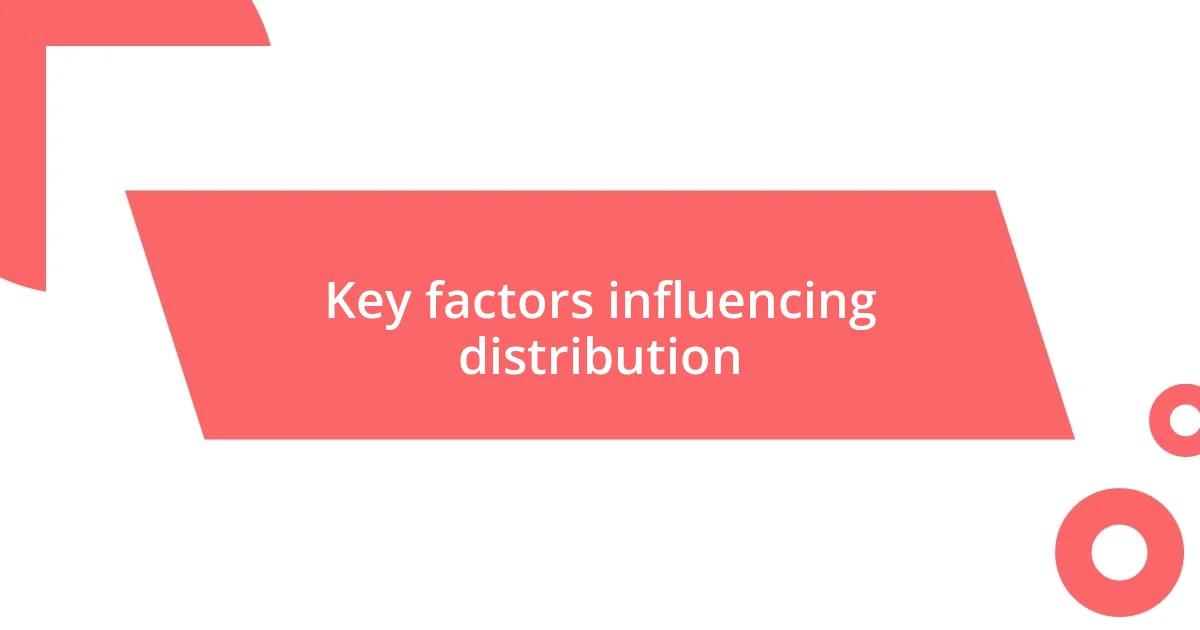Key takeaways:
- Understanding regional dynamics and local culture is essential for crafting effective distribution strategies that enhance customer satisfaction and brand loyalty.
- Thorough market research helps identify consumer preferences, competitors, and market trends, allowing for proactive adjustments in distribution plans.
- Future trends in distribution will focus on automation, sustainable practices, and hyper-localization to better meet customer needs and enhance operational efficiency.

Understanding regional distribution strategies
When it comes to regional distribution strategies, I often reflect on how different geographical areas demand unique approaches. For instance, I remember a time when I was involved in crafting a distribution plan for a product launch in a diverse market. Each region had distinct preferences and logistical challenges, which made me realize that understanding local dynamics is key to effective distribution.
Have you ever considered how local culture influences distribution strategies? It’s fascinating to think about how what works in one region might flop in another. In my experience, tailoring distribution based on cultural nuances not only enhances customer satisfaction but also increases brand loyalty.
I’ve seen how technology can play a crucial role in optimizing regional distribution. Implementing data analytics to track consumer behavior and preferences has opened my eyes to the potential of creating personalized experiences. It’s more than just delivering products; it’s about understanding the emotional connection customers have with their preferred channels and responding accordingly.

Importance of market research
Conducting thorough market research is essential for any successful distribution strategy. I’ve seen firsthand how comprehensive insights into consumer behavior can reveal trends that might not be immediately obvious. For example, when I was tasked with launching a tech product, we discovered that customers in one region preferred online purchases while another favored brick-and-mortar shopping. This knowledge helped us allocate resources more effectively and meet customer preferences head-on.
Effective market research also identifies competitors and their strategies. In a past project, I conducted comparative analysis against competitors in a specific territory. I felt quite overwhelmed at first, but as I sifted through the data, insights began to emerge. We pinpointed gaps in the market and crafted our distribution plan to fill those voids, leading us to a significant increase in market share.
Furthermore, market research aids in anticipating shifts in consumer demand. I remember a campaign where we were caught off guard by an unforeseen trend that peaked suddenly. Luckily, we had data from ongoing research, allowing us to pivot quickly and adapt our distribution, ultimately salvaging what could have been a failed launch. Being proactive instead of reactive can be a game-changer in regional distribution strategies.
| Aspect | Importance of Market Research |
|---|---|
| Consumer Insights | Helps identify specific local preferences and purchasing behaviors. |
| Competitive Analysis | Allows you to understand competitors’ strengths and weaknesses. |
| Trend Anticipation | Enables proactive adjustments in distribution strategies to meet shifting demands. |

Key factors influencing distribution
Certainly! Here’s the content for the section on ‘Key factors influencing distribution’:
Understanding the key factors influencing distribution is like piecing together a complex puzzle. For instance, I remember a situation where we had to consider infrastructure limitations in a particular region. The local delivery network was less developed than in other areas, which made me realize that operational viability must be front and center in any distribution plan. Each logistical challenge we faced pushed me to think creatively about alternative solutions that would still meet customer expectations.
Several key elements shape the distribution landscape:
- Geographical Considerations: The physical layout and infrastructure of an area can impact delivery efficiency.
- Consumer Behavior: I’ve noticed firsthand how local preferences can greatly influence buying habits.
- Regulatory Environments: Different regions often have varying regulations that can affect distribution methods.
- Cultural Factors: Understanding the local culture can help tailor communication and service options to enhance customer engagement.
These factors are not just data points; they reflect human experiences and preferences that drive our decision-making processes in distribution strategies.

Developing a regional distribution plan
When developing a regional distribution plan, I find that it’s crucial to start with a detailed assessment of local logistics. I once collaborated with a team in a region where the terrain was rugged and delivery vehicles struggled to reach certain areas. This prompted us to explore partnerships with local transportation providers who had the experience and knowledge of the landscape. Don’t you think that leveraging local expertise can sometimes make all the difference?
Another essential aspect is aligning your distribution strategy with regional consumer preferences. I recall a particular instance where a company I worked with underestimated the importance of localized marketing. We discovered that consumers in one area reacted more positively to personalized service. By incorporating local representatives into our distribution plan, we fostered connections that significantly enhanced customer satisfaction. It made me wonder—how often do we overlook the value of community in our strategies?
Furthermore, technology plays a vital role in shaping effective regional distribution plans. When I implemented a data analytics tool for a distribution project, it revolutionized our inventory management process. I was amazed by how quickly we could adjust our stock levels based on real-time demand signals. This tech-driven approach not only streamlined our operations but also provided insights that allowed us to respond promptly to market trends. Isn’t it fascinating how technology can be our best ally in navigating the complexities of distribution?

Evaluating distribution channels effectiveness
Evaluating the effectiveness of distribution channels is essential for any business strategy. I remember a time when we examined our delivery performance metrics in a specific region. Frankly, the results were both enlightening and concerning. Some channels were thriving, while others lagged behind significantly, prompting me to wonder—how can we better align our resources to maximize performance across all channels?
It’s not just about numbers; I’ve learned that qualitative feedback is equally important. Recently, after a series of customer surveys, I discovered that certain delivery methods didn’t just affect speed; they influenced customer satisfaction directly. This revelation reminded me of the power of listening to customer voices, as they often highlight inefficiencies we might overlook in our strategic evaluations. How can we truly improve if we don’t consider the end-user experience?
Moreover, I’ve found that regular assessments create opportunities for course corrections. During one review, we identified that a newly established courier service was underperforming due to lack of local knowledge. Taking immediate action, we nurtured a partnership with another local provider who had established roots in the community. This shift not only improved delivery times but also enhanced our brand’s reputation. Isn’t it fascinating how sometimes, the simplest changes can yield the most significant results?

Case studies on successful strategies
One standout example of successful regional distribution strategies that I often reflect on is a beverage company that completely revamped its distribution network. They noticed that their product penetration was particularly weak in suburban areas. By conducting focus groups, they learned that local preference leaned heavily towards convenience packaging. This discovery led them to partner with small, local retailers, creating a win-win scenario where consumers could easily access their products. Can you imagine the impact of tailoring distribution methods to fit the lifestyle of customers?
In another instance, a tech firm I worked with aimed to expand its reach in a culturally diverse region. They knew that a one-size-fits-all approach wouldn’t work, so they divided the territory into neighborhoods with distinct demographics. Each section received a unique marketing and distribution plan that resonated with its local culture. I remember the excitement as we rolled out culturally relevant advertisements alongside targeted distribution efforts. The outcome? Sales soared, and it truly highlighted how understanding your audience’s identity can elevate a brand. Isn’t it remarkable how a little cultural awareness can transform a strategy?
I’ve also seen firsthand the power of utilizing data for continuous improvement. A logistics company I was part of deployed a regional analysis tool that allowed us to visualize problem areas in real-time. During one quarter, we noticed a surge in demand for a specific product in a remote location. Adjusting our distribution routes within a week led to a notable increase in sales and customer feedback that praised our responsiveness. It reinforced my belief—how can we compete if we aren’t constantly listening and adjusting based on what the data tells us?

Future trends in distribution strategies
As I look into the future of distribution strategies, one trend that stands out is the rise of automation and AI-driven logistics. I recall a project where we integrated automated systems for order processing, which not only sped up fulfillment but also drastically reduced errors. Isn’t it exciting to think how technology can streamline operations and improve accuracy? By leveraging AI, businesses can predict demand patterns more effectively and optimize inventory management, ultimately enhancing customer satisfaction.
Another noteworthy trend is the shift toward sustainable distribution methods. During a recent collaboration with a startup focused on eco-friendly packaging, I was struck by how a commitment to sustainability resonated with consumers. It made me question—how can traditional distribution methods adapt to align with this growing consciousness? I believe that companies embracing green logistics will not only appeal to environmentally aware customers but also reduce transportation costs in the long run through efficient routing.
Additionally, the push for hyper-localization will shape future distribution strategies. I remember speaking with a retailer who scaled back their national distribution in favor of local hubs. This allowed them to cater to regional preferences while reducing delivery times. How fascinating is it that getting closer to the customer not only boosts loyalty but also creates a more agile response to market changes? As we move forward, I’m convinced that embracing local insights will be key to thriving in an increasingly competitive landscape.















